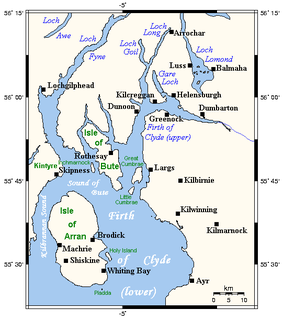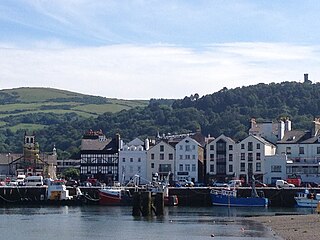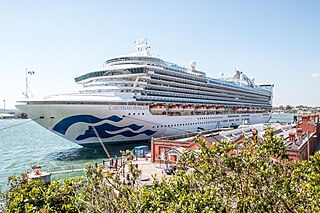
The Highlands is a historical region of Scotland. Culturally, the Highlands and the Lowlands diverged from the Late Middle Ages into the modern period, when Lowland Scots replaced Scottish Gaelic throughout most of the Lowlands. The term is also used for the area north and west of the Highland Boundary Fault, although the exact boundaries are not clearly defined, particularly to the east. The Great Glen divides the Grampian Mountains to the southeast from the Northwest Highlands. The Scottish Gaelic name of A' Ghàidhealtachd literally means "the place of the Gaels" and traditionally, from a Gaelic-speaking point of view, includes both the Western Isles and the Highlands.

The Firth of Clyde is the mouth of the River Clyde. It is located on the west coast of Scotland and constitutes the deepest coastal waters in the British Isles. The firth is sheltered from the Atlantic Ocean by the Kintyre peninsula, which encloses the outer firth in Argyll and Ayrshire. The Kilbrannan Sound is a large arm of the Firth of Clyde, separating the Kintyre Peninsula from the Isle of Arran. Within the Firth of Clyde is another major island – the Isle of Bute. Given its strategic location at the entrance to the middle and upper Clyde, Bute played a vital naval military role during World War II.

Ramsey is a coastal town in the north of the Isle of Man. It is the second largest town on the island after Douglas. Its population is 7,845 according to the 2016 Census. It has one of the biggest harbours on the island, and has a prominent derelict pier, called the Queen's Pier. It was formerly one of the main points of communication with Scotland. Ramsey has also been a route for several invasions by the Vikings and Scots.

The Isle of Mull or just Mull is the second-largest island of the Inner Hebrides and lies off the west coast of Scotland in the council area of Argyll and Bute.

Caledonian MacBrayne, usually shortened to CalMac, is the major operator of passenger and vehicle ferries, and ferry services, between the mainland of Scotland and 22 of the major islands on Scotland's west coast. Since 2006 the company's official name has been CalMac Ferries Ltd although it still operates as Caledonian MacBrayne. In 2006 it also became a subsidiary of holding company David MacBrayne, which is owned by the Scottish Government.

The Clyde puffer is a type of small coal-fired and single-masted cargo ship, built mainly on the Forth and Clyde canal, and which provided a vital supply link around the west coast and Hebrides of Scotland.

MS Caribbean Princess is a modified Grand-class cruise ship owned and operated by Princess Cruises, with a capacity of over 3,600 passengers, the largest carrying capacity in the Princess fleet until June 2013 when the new Royal Princess, another Princess ship superseded its record. She has 900 balcony staterooms and a deck of mini-suites.

The Firth of Lorn or Lorne is the inlet of the sea between the south-east coast of the Isle of Mull and the mainland of Scotland. It includes a number of islands, and is noted for the variety of wildlife habitats that are found. In 2005, a large part of the Firth became a Special Area of Conservation.

MV Caledonian Isles is one of the largest ships owned by Caledonian Maritime Assets Limited. She is operated by Caledonian MacBrayne (CalMac), which runs ferries to the Hebridean and Clyde Islands of Scotland. Caledonian Isles serves the Isle of Arran on the Ardrossan to Brodick route. As it is one of CalMac's busiest routes, Caledonian Isles has the largest passenger capacity in the fleet, and can carry up to 1000 passengers and 110 cars, with a crossing time of 55 minutes. She is used extensively by day-trippers to the Isle of Arran during the summer.

The Caledonian MacBrayne fleet is the largest fleet of car and passenger ferries in the United Kingdom, with 34 units in operation and another 2 under construction. The company provides lifeline services to 23 islands off the west coast of Scotland, as well as operating routes in the Firth of Clyde.

MV Hebrides is a ferry owned by Caledonian Maritime Assets Limited and operated by Caledonian MacBrayne from Uig to Lochmaddy and Tarbert, the main settlements of North Uist and Harris respectively.

MV Isle of Arran is a drive-through ferry owned by Caledonian Maritime Assets Limited and operated on the west coast of Scotland by Caledonian MacBrayne. Entering service in 1984, she served on the Arran service for nine years before being moved to Kennacraig. She returned to her original route in 2012, supplementing MV Caledonian Isles in summer and becoming a relief vessel in winter. In 2013, she started a new pilot route from Ardrossan to Campbeltown, which became a permanent fixture in 2015. As of 2022, she is one of the oldest vessels in the fleet, having been in service for 38 years.

Lewis and Harris, or Lewis with Harris, is a single Scottish island in the Outer Hebrides, divided by mountains. It is the largest island in Scotland and the third largest in the British Isles, after Great Britain and the island of Ireland, with an area of 841 square miles (2,178 km2), which is approximately 1% of the area of Great Britain. The northern two-thirds is called [the Isle of] Lewis and the southern third [the Isle of] Harris; each is frequently referred to as if it were a separate island.

MV Hebridean Princess is a cruise ship operated by Hebridean Island Cruises. She started life as the MacBrayne car ferry and Royal Mail Ship, initially RMS then MV Columba, based in Oban for the first 25 years of her life, carrying up to 600 passengers, and 50 cars, between the Scottish islands.
MV Glen Sannox was a Clyde car ferry launched in 1957. Built for the Arran service, she spent her first 14 years there. Thereafter, she had a versatile career on the west coast of Scotland, lasting over 32 years, including providing cruises between 1977 and 1982. In 1989, she was sold for service on the Red Sea. She ran aground south of Jeddah and lay in a sunken condition from 2000.

MV Hebrides was the first of a trio of hoist-loading car ferries built for David MacBrayne Ltd in 1964 and operated on the Uig, Skye to Tarbert and Lochmaddy route in Scotland for over twenty years. She is the only Calmac vessel to have crossed the Atlantic. In later years, as Illyria she sailed between Italy and Albania.

David MacBrayne is a limited company owned by the Scottish Government. Formed in 1851 as the private shipping company David Hutcheson & Co. with three partners, David Hutcheson, Alexander Hutcheson and David MacBrayne, it passed in 1878 to David MacBrayne.

Caledonian Maritime Assets Limited owns the ferries, ports, harbours and infrastructure for the ferry services serving the west coast of Scotland, the Firth of Clyde and the Northern Isles.

















